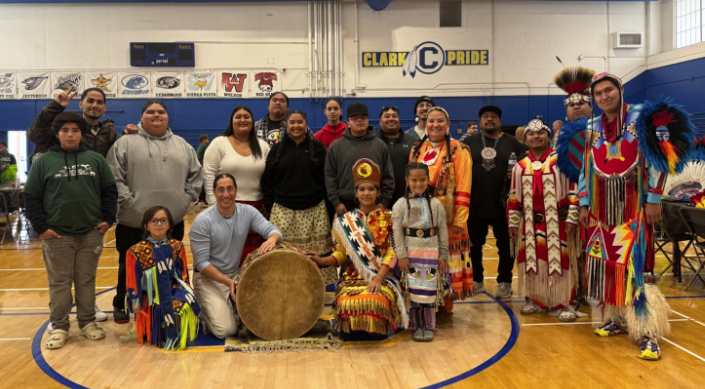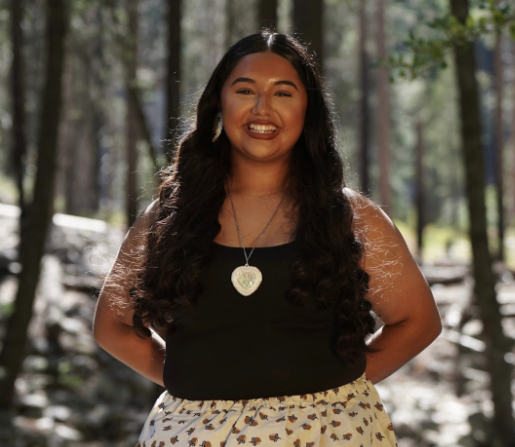
- Details
- By Kaili Berg
Bella Garcia, a senior at Clovis High School in California and a citizen of the North Fork Rancheria of Mono Indians, has spent her senior year pushing back against school officials who say she can’t wear her full tribal regalia at graduation.
While the district says students can wear eagle feathers, they’ve told Garcia she can’t wear a beaded cap, tribal stole, or other items that hold significant cultural meaning.
“I’ve been told no so many times,” Garcia said. “But I’m not backing down.”
In 2018, California passed Assembly Bill 1248, which amended the state’s education code to explicitly allow Native American students to wear items of cultural or religious significance at graduation ceremonies.

The law was written by Assembly member Todd Gloria and accompanied by Assembly member James Ramos (Serrano/Cahuilla), is the first California Native American elected to the legislature.
AB 1248 is intended to protect Native identity and uphold tribal sovereignty in school settings, but enforcement varies widely by district.
Now, nearly six years later, Ramos has introduced new legislation to close the loopholes. His new bill, AB 2335, would make it clear that only the student and their family, not school administrators, can decide what counts as tribal regalia.
“It’s crazy that we need a bill to say that Native people know their own traditions,” Garcia said. “But places like Clovis Unified make it necessary.”
Garcia’s activism started long before her senior year. In November 2023, she participated in Clovis Unified’s first Native American Student Success Conference. By spring 2024, she organized a powwow performance for the school’s “Cultural Mosaic” event, only to be cut off mid-performance by a school vice principal.
Last May, she submitted paperwork to re-establish the school’s Native American and Indigenous Peoples Club for the first time since 2008. By December, school administrators had informed her they would no longer meet with her, and referred her up the chain of command.
Despite the resistance, Garcia continued meeting with advocates from California Indian Legal Services, the ACLU, Indigenous Justice, and her tribe.
She brought her concerns to advisory boards, state agencies, and even the Department of Justice. On Thanksgiving Day, she addressed 5,000 people at the Sunrise Ceremony on Alcatraz Island.
In response to inquiries from Native News Online, the district’s Chief Communications Officer said Clovis Unified “has not received any notices that have been denied for the current year” regarding cultural adornments.
However, Garcia and her legal team argue that the denial has been largely verbal and not official. Bella says she received repeated “no’s” from the school’s principal, vice principal, and learning director over the past year and a half.
According to Garcia, the district delayed releasing its official adornment form until April, leaving little time for students to formally submit requests, especially those who had already been discouraged or turned away informally.
“The denial doesn’t always come in writing,” Garcia said. “It’s in the way they speak to you, the way they avoid you, the hoops they make you jump through.”
A formal civil rights complaint filed in September 2024 supports Garcia’s claims. Submitted by the ACLU and California Indian Legal Services, the complaint alleges that Clovis Unified uses its “approval process” to create unnecessary barriers for Native students, in violation of California Education Code 35183.1.
In April 2025, Clovis Unified released a new version of its “adornment policy,” capping students at two cultural adornments and requiring certain items, like basket caps, to match the school’s graduation colors.
Garcia said this misrepresents Native traditions, noting that regalia is handmade using materials from the land and not manufactured in school colors.
Garcia, who has maintained a GPA above 4.0 while advocating throughout her senior year, plans to attend Fresno City College in the fall.
“I’m doing this for the ones who didn’t get to graduate. For the ones who never came home from boarding schools. For my community,” Garcia said.
On May 29, Garcia and four other Native students at Clovis High plan to walk in full regalia. Whether the district honors that right, or tries to stop them, remains to be seen.
“This is more than a cap and gown,” Garcia said. “This is about being seen. About saying “we’re still here.”
More Stories Like This
Yazzie/Martinez Draft Plan Angers New Mexico Indigenous Education Experts and AdvocatesMorongo Breaks Ground on New Tribal Elementary School
"Power in Culture" Study Reveals Key Drivers of Belonging for Indigenous College Students
Native American All-American Football Game Returns to Vikings Stadium, Adds Girls' Flag Football Clinic
Michigan Relaunches Resource Guide to Support Native American Students
Help us tell the stories that could save Native languages and food traditions
At a critical moment for Indian Country, Native News Online is embarking on our most ambitious reporting project yet: "Cultivating Culture," a three-year investigation into two forces shaping Native community survival—food sovereignty and language revitalization.
The devastating impact of COVID-19 accelerated the loss of Native elders and with them, irreplaceable cultural knowledge. Yet across tribal communities, innovative leaders are fighting back, reclaiming traditional food systems and breathing new life into Native languages. These aren't just cultural preservation efforts—they're powerful pathways to community health, healing, and resilience.
Our dedicated reporting team will spend three years documenting these stories through on-the-ground reporting in 18 tribal communities, producing over 200 in-depth stories, 18 podcast episodes, and multimedia content that amplifies Indigenous voices. We'll show policymakers, funders, and allies how cultural restoration directly impacts physical and mental wellness while celebrating successful models of sovereignty and self-determination.
This isn't corporate media parachuting into Indian Country for a quick story. This is sustained, relationship-based journalism by Native reporters who understand these communities. It's "Warrior Journalism"—fearless reporting that serves the 5.5 million readers who depend on us for news that mainstream media often ignores.
We need your help right now. While we've secured partial funding, we're still $450,000 short of our three-year budget. Our immediate goal is $25,000 this month to keep this critical work moving forward—funding reporter salaries, travel to remote communities, photography, and the deep reporting these stories deserve.
Every dollar directly supports Indigenous journalists telling Indigenous stories. Whether it's $5 or $50, your contribution ensures these vital narratives of resilience, innovation, and hope don't disappear into silence.
 The stakes couldn't be higher. Native languages are being lost at an alarming rate. Food insecurity plagues many tribal communities. But solutions are emerging, and these stories need to be told.
The stakes couldn't be higher. Native languages are being lost at an alarming rate. Food insecurity plagues many tribal communities. But solutions are emerging, and these stories need to be told.
Support independent Native journalism. Fund the stories that matter.
Levi Rickert (Potawatomi), Editor & Publisher

